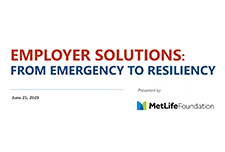Discover financial empowerment resources
Discover financial empowerment resources
In light of COVID-19, the financial security of workers has never been more in question. The workplace is an important delivery channel for tailored financial products and services that can help meet employee’s immediate financial needs and build long-term financial stability. The workplace is a...

Income inequality in the United States is growing, but the most common economic statistics hide a significant portion of Americans’ financial instability by drawing on annual aggregates of income and spending. Annual numbers can hide fluctuations that determine whether families have trouble...
One of the core findings of the US Financial Diaries is the prevalence of income volatility. On average, our households experience six months when income is 20% above or below their typical monthly income. In theory, households should react to volatile incomes by building up savings in months where...
The Rodriguez’ enjoy a measure of financial health and security. Maria and her husband, Dean, will soon have the first mortgage paid off on their four-bedroom, two-bathroom house. Buttressed by regular payments from Social Security and other federal benefits, the five members of the household...
In this issue brief, we explain what informal finance is and how informal savings and borrowing tools are used; some reasons why people use such informal tools; the benefits, costs and limits of informal finance; and the implications of these findings for financial services providers and...
To assess the current state of financial health in America and to glean insights that can inform cross-sector efforts to improve consumer outcomes, CFSI designed and commissioned a nationally representative survey focused on consumers’ financial behaviours, attitudes, and preferences. This report...
This is a household profile of a participant in the U.S. Financial Diaries project. Mateo Valencia, 31, and Lucia Benitez, 30, are an unmarried couple living in Queens with their four year- old son Pablo. Mateo and Lucia are undocumented immigrants, and the realities and dangers of living in the...
We deployed field researchers into communities in California, Mississippi, New York, Ohio, and Kentucky to delve into the intimate financial details of approximately 200 households. Over the course of a year, field researchers visited each family once or twice a month, logging detailed information...
This is a household profile of a participant in the U.S. Financial Diaries project. Mike Smith, a single man in his mid-50s, lives in a two-bedroom, one-bathroom house in Kentucky, in a small town near the Ohio River. Even though his resources are limited, he manages to save by strictly controlling...
This is a household profile of a participant in the U.S. Financial Diaries project. Lauren Walker, 29, is a single mother living with her four-year-old son Riley in a rented townhome in a small town in eastern Mississippi. Lauren works full time as an administrative assistant for a local...
This is a household profile of a participant in the U.S. Financial Diaries project. Sandra Young, 52, is an African American woman living in Brooklyn with her grown children: Tyler, 25, and Kayla, 24. Sandra manages several branches of a tax preparation agency, which means that she earns most of...
New financial services cannot increase household incomes. However, there is tremendous potential for high-quality financial services to help households achieve greater financial health and better manage income uncertainty. In this research note, we explore the concept of uncertain incomes through...
For unbanked and underbanked borrowers, ncome supports, budgeting guidance, and additional savings will not entirely fill the need that credit satisfies. First, well-structured credit can support a household’s ability to save. Second, building a credit history is a critical financial asset in its...
The Center for Financial Services Innovation (CFSI) has conducted an investigation into the amounts that prepaid cardholders spend each month to conduct essential financial transactions, and compared that to the amounts that they would spend if they remained underbanked or used checking accounts...
